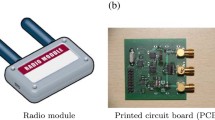Abstract
This paper introduces a method of shaping impulse radio Ultra Wideband (UWB) pulses in the context of using higher than normal power transmissions and cognitive radio to provide the ability for such systems to avoid interference with primary users in shared radio spectrum. Using multiple shaping frequencies and a standard Gaussian pulse shape, pulses are shaped in the time domain, according to the requirements of the frequency spectrum in use, and any limits on power spectral density. Simulation results are presented for an example scenario based on measured data, along with a more general approach applicable to a free spectrum scenario. We show that the introduced shaping technique ensures that up to 98.8% of capacity of the UWB bandwidth within the conventional spectrum mask can be achieved for a time scaling factor of 11 ns and shaping frequency of 30 MHz. Capacity well in excess of the 100% achievable with the spectral mask is possible when the transmit power is permitted to increase in areas of ‘white space’ spectrum.
Similar content being viewed by others
References
Ghavami M. et al (2007) Ultra wideband signals and systems in communication engineering. John Wiley & Sons Ltd, West Sussex, England
Siwiak K., McKeown D. (2004) Ultra-wideband radioTechnology. John Wiley & Sons Ltd, West Sussex
FCC (April 2002). First Report and Order.
Mitola J. (2006) Cognitive radio architecture: The engineering foundations of radio XML. John Wiley & Sons, Hoboken
Bin, L., et al. (2010). Interference mitigation between ultra-wideband sensor network and other legal systems. EURASIP Journal on Wireless Communications and Networking, 2010.
Ohno K., Ikegami T. (2006) Interference mitigation study for UWB radio using template waveform processing. IEEE Transactions on Microwave Theory and Techniques 54: 1782–1792
Zhang H. et al (2006) Multiple signal waveforms adaptation in cognitive ultra-wideband radio evolution. IEEE Journal on Selected Areas in Communications 24: 878–884
Xianren W. et al (2006) Optimal waveform design for UWB radios. IEEE Transactions on Signal Processing 54: 2009–2021
Chakravarthy, V. D. et al., (2007). A general overlay/underlay analytic expression representing cognitive radio waveform. In International waveform diversity and design conference (pp. 69–73).
Riaz, N., & Ghavami, M. (2006). Performance comparison of ultra-wideband time-hopping, DSSS and OFDM multiple access schemes for wireless sensor networks. In IEEE wireless communications and networking conference, WCNC (pp. 786–791).
Siriwongpairat W. P., Liu K. J. R. (2007) Ultra-wideband communications systems: Multiband OFDM approach. John Wiley & Sons Ltd, New Jersey, USA
Hamalainen, M., & Iinatti, J. (2005). Analysis of interference on DS-UWB system in AWGN channel. In IEEE international conference on ultra-wideband (pp. 719–723).
Hyseni, A., et al. (2008). Comparative investigation of performance of ultra-wideband multiple access schemes for wireless sensor networks. BT Technology Journal, 26.
Urban R., Zvanovec S. (2008) Dispersion and pulse interferences investigation for UWB signal propagation. Radioengineering 17: 60–65
Urban, R., et al. (2010). Ultra wideband pulse shaping using frequency mixer. In 2010 IEEE international microwave workshop series on RF Front-ends for Software Defined and Cognitive Radio Solutions (IMWS) (pp. 1–4).
Tobagi F., Kleinrock L. (1975) Packet switching in radio channels: Part II–the hidden terminal problem in carrier sense multiple-access and the busy-tone solution. IEEE Transactions on Communications 23: 1417–1433
http://www.alvarion.com/. Alvarion: Mobile WiMAX Pioneer. Available: http://www.alvarion.com/.
Padgett, J. E., et al. (2003). Physical-layer modeling of UWB interference effects. Wireless Systems and Networks Research, Telcordia Technologies.
Author information
Authors and Affiliations
Corresponding author
Rights and permissions
About this article
Cite this article
Urban, R., Grace, D. & Pechac, P. Impulse Radio UWB Pulse Shaping for Cognitive Radio Applications. Wireless Pers Commun 63, 675–688 (2012). https://doi.org/10.1007/s11277-010-0158-6
Published:
Issue Date:
DOI: https://doi.org/10.1007/s11277-010-0158-6




